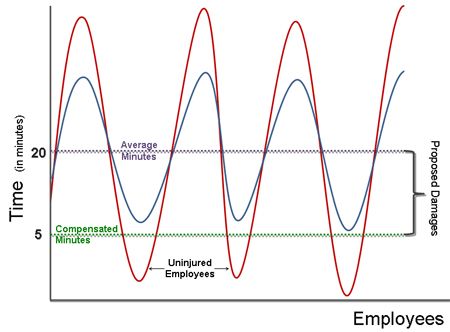You run a business. You sell actual products. You employ hundreds, or even thousands, of warm-blooded employees, all with names, families, and histories. You battle real competitors daily. Your customers, thank goodness, are real too – they fill their trucks, warehouses, stores, or homes with your products, call you when you come up short, and praise you, one hopes, when you exceed expectations.
But when you are in court, fighting for what could be the life of your company, an entirely fictional figure often comes to the fore: the "average" customer (or employee, competitor, etc.). In class action practice this "Average Joe" or "Jane Doe" is especially prolific. He or she can be put forth as the flag bearer for injured consumers, or the benchmark against which damages to all should be measured. The Supreme Court will review this practice in the context of wage and hour class actions thanks to a recent certiorari grant, with likely spillover effects into antitrust class actions, where averages have long been invoked for various reasons.
In Tyson Foods, Inc. v. Bouaphakeo, et. al., the Eighth Circuit upheld certification of a class, and a decision on the merits, in favor of workers at a Tyson Foods meat-processing plant. Those workers sued Tyson for undercompensating them for time spent walking to their worksites and "donning and doffing" protective equipment necessary to perform their jobs. A critical input into the plaintiffs' damages model was the average amount of time it took a sample of workers to don and doff, and to walk to and from their work stations. The parties and the court agreed that this amount of time varied by job type and employee preference – some whose job included the need to wield and use sharp knives donned more equipment than those with less dangerous duties, and even within these two broad types of employees Tyson provided discretion as to the materials used. Tyson also afforded different types of employees different amounts of paid "don and doff" time, and compensated the same type of employees different amounts depending on whether they worked on set-up, regular, or tear-down shifts.
Once this average was calculated by the first of plaintiffs' experts, a second took that average, compared it to each employee's actual pay record, and calculated how much each was due if credited with the average worker time for every day of the class period. The aggregation of those amounts, less actual pay, was put forth as plaintiffs' class-wide damages. As the case wound through the courts, major developments, particularly as to the rigor required of damages models, emerged. In particular, in Wal-Mart v. Dukes, the Supreme Court rejected "trial by formula," where a sample set of class members would be selected, with the percentage of their claims determined to be valid and the amount they were owed to then be applied classwide. In Comcast v. Behrend, the Supreme Court held that if damages are to be adjudicated on a classwide basis, then they must also rest on classwide, common proof, and cannot be established using an "arbitrary" measure.
Nonetheless, the district court certified the class and the Eighth Circuit affirmed. In distinguishing Dukes and Comcast, the Eighth Circuit suggested that "plaintiffs [did] not prove liability only for a sample set of class members" but "for the class as a whole, using employee time records to establish individual damages." While it conceded that plaintiffs "do rely on inference from average donning, doffing, and walking times," they did "apply this analysis to each class member individually." This "representative evidence is comparable to a jury applying testimony from named plaintiffs to find classwide liability." Its decision was also said to be consistent with traditional modes of proof in employment classes dating to the Supreme Court's 1946 decision in Anderson v. Mt. Clemens Pottery Co. The Supreme Court's cert grant, however, is a strong signal that a number of its members, at least, disagree, as the Circuit split on the issue was relatively limited.
In the world of antitrust, averages – to establish average prices, average overcharges, the ability of an average rival to compete, and the like – are frequently invoked, with mixed results. The Fifth Circuit in Bell Atlantic v. AT&T rejected a damages formula that relied on average labor costs and time savings class members would have achieved if caller ID services – allegedly monopolized by AT&T – had been available. In the Wholesale Groceries case, the Eighth Circuit rejected class certification premised in part on a "variance" test that compared actual to average grocery prices. In contrast, the Tenth Circuit in In re Urethane Antitrust Litig. held that the use of extrapolation techniques is acceptable to decide classwide damages, but not liability. That decision was particularly notable because it is the mirror image of the Ninth Circuit's recent decision in Jimenez v. Allstate Ins. Co., which held "that statistical sampling and representative testimony are acceptable ways to determine liability" but may not be "expanded into the realm of damages."
Particularly as antitrust plaintiffs and regulators offer more and more sophisticated looking models, it is important to note that the use of averages and "sampling" is inherently suspect when determining impact. Because their very nature is to wipe out differences among class members – and thereby provide them with something in "common" – averages warrant special scrutiny. For example, a class of two customers with an "average" overcharge of $50 may simply be one customer overcharged by $100, and one by $0, giving them nothing in common, once unpacked. Given modern analytical tools, coupled with permissive discovery, there should be little need to resort to what a "typical" or hypothetical class member might do or pay. Actual sales, cost, and pricing information is generally available, and will be ignored for averages or samples only if unfavorable.
While actual "don and doff" and walking times might be harder to come by in a case like Tyson, the Eighth Circuit's reasoning, and the district court's before it, still appears to have been unsound. That is because the average utilized served so many masters: as common evidence binding the class; as a yardstick to establish liability; and as the benchmark against which actual pay would be deducted to award damages. As common evidence, the question under Dukes is whether it helps resolve a case-critical issue in "one stroke." On the issue of liability to the class, this evidence does not do so. An average does not divulge whether it was generated by a group of workers who required far more, and far less, than the average time, or by a class of workers whose times were tightly bound. But this is the important question. Since Tyson provided some don and doff compensation (four to eight minutes worth) to all class members, it cannot be "liable" for under-compensating the group of relatively fast dressers that it properly compensated. The Eighth Circuit did not appear to have fairly grappled with this.
As common evidence to establish damages, however, the issue is trickier. Since the time of Justice Story, who sat on the Court 200 years ago, litigants have been given greater leeway to establish damages, once liability is shown. In modern times, particularly in antitrust cases, regression analysis and control group methodologies provide a form of averaging and are frequently accepted to show damages. That is not to say that any damages model will do. In Comcast, for example, the model fell short because it did not match the liability theory, while in Rail Freight, the repudiated model found harm to purchasers who could not conceivably have been injured. But a model should hold up if rigorously constructed, well-specified, and reasonable. In a case like this one the following graphic illuminates when a model using an average as an input might qualify.

Here, both the blue line and the red line generate a twenty minute don/doff average submitted by a damages expert as a benchmark. But the blue line workers all required more than the five minutes the defendants provided compensation for. Sure, some blue line members required more than the twenty minutes the model says they should be paid for – but these members can opt out of the class if they believe they can do better. The red line members, however, are more disparate and include many who were properly compensated. Damages awarded to these members would violate the teachings of Comcast and Rail Freight, and the model (and testimony based upon it) should not form the basis for a jury verdict.
In Comcast, the Supreme Court proved willing to delve into the nitty-gritty of expert modeling. Doing so here may give rise to a narrow decision condemning the lower court's inquiry of the model in question, versus a broad statement for, or against, sampling and averages. That is because in Tyson, the sampling method used appears to have been neither random nor rigorous (the expert's assistants apparently just timed those workers in view during their "survey"), as it did not appear to control for preference, shift, or other important factors. Accordingly, there does not appear to be a sound basis to describe this evidence as "representative."
Even if the model were otherwise appropriate, the parties and experts appear to agree that many class members are like those in the bottom part of the graphic above – i.e., properly-compensated red line types. That could make critical the Court's disposition of the second question presented by the Petition, whether certification of a class containing "hundreds" of uninjured class members (within a certified class of 3,344 people) violates the Rules Enabling Act and Article III standing requirement. If the model is well-specified, and the Court permits certification of a class including a significant number of uninjured members, then there is nothing left to complain about. On the flip side, if the model is well-specified but the class is not because so many members lack standing, then the Eighth Circuit would be reversed.
But the most interesting question concerns the fate of "Average Joe." If his use is rightly limited to, at most, a post-liability damages input in a well-specified model, the court will continue its trend of insisting on rigor and rationality, leavened further with, in class action procedure, reality.
The content of this article is intended to provide a general guide to the subject matter. Specialist advice should be sought about your specific circumstances.

